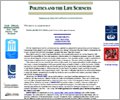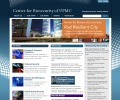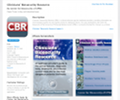 The National Academies are committed to providing clear, objective, evidence-based information and advice to the Nation.
The National Academies are committed to providing clear, objective, evidence-based information and advice to the Nation.
On this website, we have pulled together information about National Academies’ reports, ongoing projects, and activities. We hope this will make it easier to find the many resources available from this institution. The site also includes links to some of the growing number of biosecurity websites in the United States and overseas.”
- Author:
- The National Academy of Sciences
- Publish Date:
- April, 2012
- April 30, 2012
- | Filed under North America and Website
- Share
 Online educational materials have been created for life scientists by life scientists. The materials are designed primarily for use by students embarking upon their careers – advanced undergraduates and first-year graduate biology and medical students – and for their teachers. Any not-for-profit use is encouraged, including instructional use in colleges, universities, and other institutions. Currently the project is hosted by Politics and the Life Sciences.
Online educational materials have been created for life scientists by life scientists. The materials are designed primarily for use by students embarking upon their careers – advanced undergraduates and first-year graduate biology and medical students – and for their teachers. Any not-for-profit use is encouraged, including instructional use in colleges, universities, and other institutions. Currently the project is hosted by Politics and the Life Sciences.
- Author:
- Center for Arms Control and Non-Proliferation
- July 12, 2010
- | Filed under North America and Education Module
- Share
 The Center for Biosecurity is an independent, nonprofit organization of UPMC. Its mission is to strengthen national security by reducing the risks posed by biological attacks, epidemics, and other destabilizing events, and to improve the nation’s resilience in the face of such events.
The Center for Biosecurity is an independent, nonprofit organization of UPMC. Its mission is to strengthen national security by reducing the risks posed by biological attacks, epidemics, and other destabilizing events, and to improve the nation’s resilience in the face of such events.
The Center’s website offers the following resources on biosecurity:
• Articles and Publications
• Biosecurity News in Brief
• Biosecurity and Bioterrorism Journal
• Clinicians’ Biosecurity Network
• Commentary
• Congressional Testimony and Briefings
• Events and Scenarios
• Links and Resources
• U.S. Government Documents and Related Legislation
- Author:
- Center for Biosecurity of UPMC
- June 1, 2011
- | Filed under North America and Website
- Share
 “Clinicians’ Biosecurity Resource (CBR) is a clinical reference app for healthcare providers, providing information on the 6 biological agents that are highest priority for biological attacks. This app, developed by the Center for Biosecurity of the University of Pittsburgh Medical Center (UPMC), is primarily intended for clinicians as a mobile reference during response to a biological attack, for learning about these diseases and how they might present in victims of biological attacks/bioterrorism, or as they come across suspicious or unusual cases of disease.”
“Clinicians’ Biosecurity Resource (CBR) is a clinical reference app for healthcare providers, providing information on the 6 biological agents that are highest priority for biological attacks. This app, developed by the Center for Biosecurity of the University of Pittsburgh Medical Center (UPMC), is primarily intended for clinicians as a mobile reference during response to a biological attack, for learning about these diseases and how they might present in victims of biological attacks/bioterrorism, or as they come across suspicious or unusual cases of disease.”
- Author:
- Center for Biosecurity of UPMC
- Publish Date:
- January 2012
- January 19, 2012
- | Filed under North America and Other
- Share

































